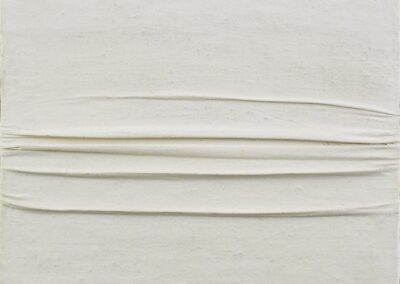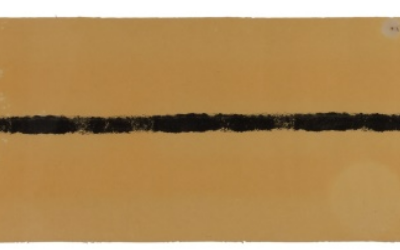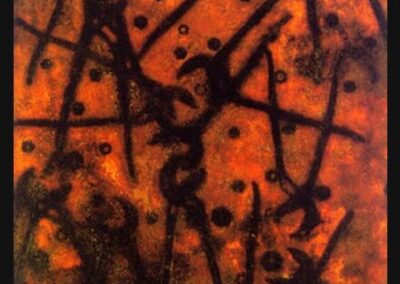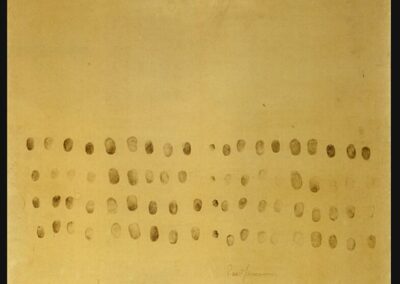The next Artist You Need To Know is Piero Manzoni (1933 – 1963).
Piero Manzoni di Chiosca e Poggiolo was an Italian artist whose approach to art making had strong elements of irony and a caustic sarcasm, often with a hint of mockery that exposed some essential truths about the avant-garde art world.
Curator Jon Thompson (of the Serpentine Galleries) asserted that “Manzoni understood the creative act as part of the cycle of consumption: as a constant reprocessing, packaging, marketing, consuming, reprocessing, packaging, ad infinitum.”
More poetically – and perhaps, more exactly – Italian designer Nanda Vigo (a contemporary of Manzoni) stated that “He [Manzoni] completely broke what everybody believed art was.”
Count Meroni Manzoni di Chiosca e Poggiolo – his full name – was born in Soncino in the Province of Cremona in the region of Lombardy (this is about 60 kilometres / 37 miles east of Milan) in Italy. Manzoni was a self taught artist whose first solo exhibition took place when he was only 23 (at the Soncino’s Castle in Soncino) in 1956. Much of his younger, perhaps ‘immature’ artworks were very expressive and gestural : the influence of Nuclear Art (a movement that saw the use of the Atomic bomb as an ‘end to history’ and tried to position itself as a new space for a ‘new’ world) and artists like Enrico Baj was very clear in his work at this time.
However, Manzoni – with his works from 1957 until 1963, when he died – would soon abandon this and produce the artworks for which he is best known : these are not easily classified objects, actions and performances that “questioned and satirized the status of the art object as it had been conceived throughout modernism. Influences include earlier yet still active artists like Marcel Duchamp and contemporaneous practitioners Ben Vautier and [previously featured Artist You Need To Know] Yves Klein.” (from here)
From The Courtauld Art Institute : “A central figure in the international neo-avant-garde scene of the 50s, Manzoni was concerned with the conceptual process of freeing paintings’ surface from the rules of representation. In 1957, he began his first ‘white paintings’, pieces that from 1959 he referred to as Achromes [a number of which are in the gallery above]. As the artist himself explained, these were the result of his experiments with the use of constantly different techniques and materials, from both the natural and synthetic world, to create a series of white surfaces where observers’ energies of thought and image might be released. They were no longer canvas prisoners of painted fiction, forced into a confined space where drawings and colours pretended to be something else. Manzoni felt he had overcome a central artistic problem of what to do with composition and form, creating a new, unrestricted aesthetic model that made tangible contact with ideas of the infinite.”
Several works that we’re sharing below continue this fracture of many assumptions about art and artmaking. These include Linee (lines) (an artist’s book that was created in 1959) and Corpo d’aria [Body of Air]. The embedded links will tell you more about each of these irreverent and groundbreaking artworks.
But perhaps his most well known – both controversial and admired – artwork is Merda d’artista [Artist’s Shit]. It is also one of the most provocative and infamous works of art in the history of the Western canon. Manzoni created this work in 1961 : the ‘limited edition’ work consisted of 90 tin cans containing Manzoni’s feces (a myth around the work is that he made this work in response to a comment from his father that his work was ‘shit’).
From here : “The cans were labeled in Italian, English, French, and German as “Artist’s Shit, contents 30 gr net, freshly preserved, produced and tinned in May 1961.” Manzoni’s work was a direct critique of the commodification of art. By packaging and selling his excrement as art, he was questioning the value assigned to art objects and the often arbitrary nature of that value.
The piece was designed to provoke and shock the audience, pushing the boundaries of what could be considered art. It played on the notions of authenticity and the relationship between the artist and the consumer.
“Artist’s Shit” remains a powerful commentary on the nature of art, value, and consumerism. It continues to be exhibited in major museums and galleries around the world, and its influence can be seen in the works of later conceptual and contemporary artists.”
Contemporary multidisciplinary performance artist Marina Abramović, in speaking of Manzoni’s artwork and the influence it had upon her, asserted that: “I have a freedom as an artist to make art out of dust if I want.”
Other significant artworks by Manzoni that challenged art world ideas and aesthetics include the following: Magic Bases [Magisk Sockkel], 1961 (a series of wooden plinths that people were encouraged to stand upon, to act as – or ‘acquire the status of being’ – “Living Sculpture”) : Base of the World [Socle du Monde], 1961 (this massive metal plinth was installed upside down in an open field in Herning, Denmark. It is inscribed with the text “The Base Of The World, Homage To Galileo.” Continuing Manzoni’s desire to question the contextual role of artist and art, he intended this piece to convey that the “whole world is a work of art, rendering the artist obsolete”): The Consumption of Dynamic Art by the Art-Devouring Public, 1960 (while giving an artist talk, Manzoni “marked hard-boiled eggs with his thumbprint, insisting that by doing so they became “art”. He then ate one of the eggs before offering the rest to the public. Manzoni saw the consumption of the eggs as fulfilling his desire for the work to disappear. He also suggested that by eating the egg, the consumer becomes an artwork due to their contact with the artist’s hand”); and Piero Manzoni; The Life And Works (1963). This work was an artist’s book (published posthumously) : it is comprised of 100 sheets of transparent plastic bound to a white metal sheet. Except for the text on the title page, the entirety of the ‘book’ is completely blank. (quotes are from The Art Story)
His work was most often exhibited at Galleria Azimuth in his native Italy, but Manzoni has been been featured in many international venues as well. Notable exhibitions include retrospectives at the Musée d’Art Moderne de la Ville de Paris (1991), Castello di Rivoli-Museo d’Arte Contemporanea (1992), the Serpentine Gallery, London (1998), at the Museo d’Arte Contemporanea Donnaregina, Naples (2007) and the massive exhibition Piero Manzoni: Materials of His Time which began in 2019 and was on view in both NYC and Los Angeles through Hauser & Wirth’s galleries.
Manzoni’s evocative artworks can be found in the collections of the Museum of Modern Art, New York; Stedelijk Museum, Amsterdam; Tate Modern, London; the Galleria Civica d’Arte Moderna e Contemporanea, Turin; and the Museum of Contemporary Art Villa Croce in Genoa.
He passed away from a myocardial infarction in 1963 while working in his studio in Milan. He was only 29 years old and had been making artworks for the shockingly brief span of 1956 to 1963. Appropriately in sync with Manzoni’s life and artwork, his death certificate was signed by his colleague Ben Vautier – often known simply as Ben and part of the Fluxus art movement which had much in common with Manzoni – and designated it a work of art.
More of Manzoni’s work – and much more about his legacy – can be seen here at Fondazione Piero Manzoni. There is also a very in depth entry on Manzoni that can be enjoyed at The Art Story. A short video wherein a number of contemporary artists speak about Manzoni’s ongoing relevance to their own practice and the larger art world can be watched here.























